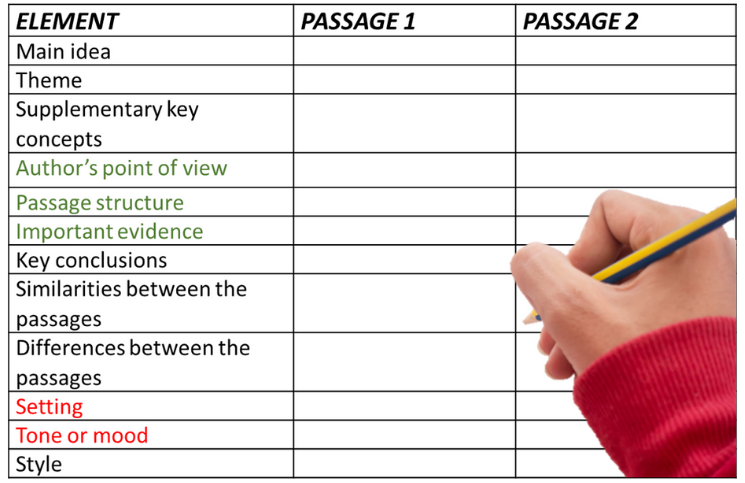MCAS Next Gen 2.0 ELA – Expect greater emphasis on text comparison.
by Joan Reissman, MCAS Maven
The biggest change in the MCAS Next Gen 2.0 ELA test, coming to 10th grade next month, is a greater emphasis on text comparison. Although people read every day, much of the reading students do on the phone or computer is recreational. Nobody is going to quiz you on detailed comprehension after you read something on social media. There is ongoing debate over whether students comprehend better on paper or screen. But it’s academic to us, because Next Gen MCAS is coming on a screen.
Most of the questions on the new ELA MCAS will be comparing two texts. Teachers and parents need to prepare students for this higher level of complexity. The test is requiring them to double their efforts and multi-task. They will need to have both a thorough understanding of two texts and the relationship between the texts. They will need to understand all of the elements in each passage, as well as how the two passages compare and contrast. If this sounds like a lot, that’s because it is.
The sample practice test on the DESE website has comparisons between two pieces of non-fiction. However, the questions featuring two texts on previous MCAS tests used selections of fiction. In order to be fully prepared for the new ELA, students need to practice comparing both two fiction passages and two pieces of non-fiction. The techniques are similar but there are some important differences in the elements.
When you are reading passages on the MCAS, you have to be aware of all the major elements such as main idea, theme, drawing conclusions and point of view. However, on the fiction passages you also need to be aware of literary elements such as tone, style, mood and figurative language. In the non-fiction pieces, you need to focus on argument structure and evidence. These elements don’t apply to fiction.
The MCAS will give you two texts on related topics. The differences might be in the style, point of view or even the facts. The first two passages on the sample ELA test focus on a famous photograph by Dorothea Lange. The two passages discuss the same photo, but one passage describes it from the photographer’s point of view, while the other passage focuses on the contrast between the photographer and the subject. In other examples, a second passage might zoom in on a specific example of the concept discussed in the first passage. As a test-taker, your primary job is to zero in on the similarities and differences.
The most important thing when reading two texts is to stay focused. It’s a terrible feeling to get to the end of a passage and realize that you have been reading passively and can’t remember what you just read. Don’t let this happen to you while taking a test. The first technique for better reading comprehension is to use the highlight tool. Highlight the main idea in each paragraph. There is a dark circle with a number next to each paragraph, so it will be easy to keep track of paragraphs. Try to isolate the main idea and don’t underline too much in one paragraph. Once you select some text, you can highlight. There is also a tool to erase the highlight if you change your mind. As you are reading the selection, use the digital notepad (at the top of the screen) to jot down main ideas. You can move the notepad around the screen so that you’re not blocking the text. As you read, make a simple numerical list of paragraphs in the notepad. After each paragraph, write a few words about the paragraph. Don’t make this too complicated or you will use up a lot of time and get lost in the details.
You can also try skimming the questions before you read the passage. Some students find that this helps them answer the questions faster, because knowing the questions beforehand helps focus their attention and note taking while they are reading.
Until this year, high school students were given a booklet for paper-based MCAS exams. Students were not given any scratch paper because they could write everything in the test booklet. Since there is no test booklet for the online MCAS 2.0, students will have some options. Students will be allowed to use scratch paper or a personal whiteboard during the test. You will be issued one piece of scratch paper per session, but you can request more if needed. Use one of these options to make a comparison chart for your two passages. Some educators recommend making a Venn diagram (two overlapping circles) to compare two texts, but a Venn diagram can get messy if you put in a lot of information. A simple two- column comparison chart will be faster and more effective. You could put this chart in the notepad, but it’s easier to make the chart on paper so you don’t have to keep toggling around between the question and the passage and the chart.
Making a chart that’s simple but effective is the key to solving questions that involve higher order thinking skills.
When you were noting the main ideas in your first list, you should have been concentrating on basic comprehension. You just needed to write down the major concepts to be sure that you were staying focused in your reading. Now, in the two-passage chart, you want to concentrate on major elements that lend themselves to comparison and contrast. Focus on a few major elements, so that you don’t spend too much time. The chart is supposed to help you quickly provide analysis, so again, don’t put in too many elements or details. If you add a lot of supporting details and minor points, your chart will be too long and complicated to be useful. This chart is just a guide, so stay with the basics. If you can’t think of anything for a particular element, just leave it blank.
The elements of your chart should include primary main idea, theme, supplementary main ideas, passage and/or argument structure, key evidence, author’s purpose, primary conclusions, passage similarities, and contrasting points of view or facts. If you are comparing two fiction pieces, add style, tone and setting.
Your chart should look like this:

The green topics are for non-fiction, the red are for fiction. The rest are for both.
Many students think it’s difficult to juggle questions about two passages. Well it is, because there is so much information to retain. That’s why it’s so important to have a simple memory tool to guide your analysis. A chart like this will actually save you time and guard against forgetting important points in the heat of the exam. If you create the structure, you’ll find comparing two texts is not so difficult, and your MCAS score will reflect your efforts.
Remember that you don’t need a perfect score to get Proficient (or Meeting Expectations, as the new rubric calls it). If they follow the same grading practices as in the past, you’ll need about 50%. So don’t be discouraged if you can’t answer every question. The test is in two sections. In each section, you can go back and change answers or fill in questions you skipped before you submit the section. Once you submit, you can’t go back. Answer what you can, skip what you can’t, and then go back and try to fill in more. There’s no penalty for wrong answers, so even if you’re not sure, guess. If you have done your preparation, you’ll be OK.
If you have any questions, send them in. I’ll do my best to answer them. And take a moment to review my previous post on ELA, Preparing for MCAS 2.0 Reading Comprehension.
Joan Reissman, the MCAS Maven, is a veteran Blended Learning Specialist with JFYNetWorks. She has been analyzing state curriculum standards and MCAS tests since 2000.











